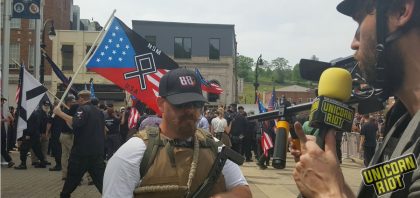As Course of War Turns, Turkey Challenges Democratic Federation of Northern Syria (Rojava)
Democratic Federation of Northern Syria (Rojava Cantons) – A Unicorn Riot contributor reports from Syria the quiet aftermath scene of an April 2017 attack by Turkish armed forces on a media center and military base operated by the YPG (People’s Protection Units, KU: Yekîneyên Parastina Gel, AR: وحدات حماية الشعب) and YPJ (Women’s Protection Units, KU Yekîneyên Parastina Jin, AR: وحدات حماية المرأة).
The YPG and YPJ are the largest military formations within the Syrian Democratic Forces (SDF), a coalition of armed popular militias defending the Democratic Federation of Northern Syria. They are aligned with Syria’s Democratic Union Party or PYD (KU: Partiya Yekîtiya Demokrat, AR: حزب الاتحاد الديمقراطي).

Within the six and a half years of Syria’s churning uprising-turned-civil-war, domestic and international parties have formed ad-hoc alliances and sets of proxy relationships with smaller armed groups, sometimes shifting between armed conflict and tense mutual arrangements.
It’s a complicated arena (as seen on the complicated color-coded map below); in this article we’ll focus on northern Syria and the factors that gave rise to the modern Turkish-Kurdish side of the Syrian conflict.
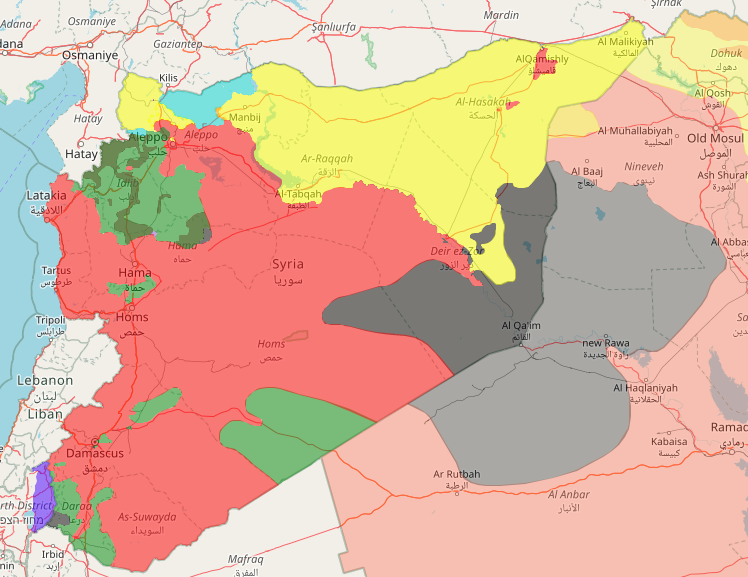
In 2016, the YPG/YPJ, with support from the United States, led the SDF’s Manbij offensive west of the Euphrates River. This successful offensive cleared the Islamic State of the Levant’s (ISIL) grip from north-central Syria and gave the SDF control of a long stretch of the Turkish border, uniting the Kobane and Cizire cantons.
From the Rojava, or the Democratic Federation of Northern Syria, perspective, after the Manbij campaign in this area of Syria, the PYD is the overall political power broker, while the overall federation set up here is an amalgamation of many ethnically diverse and autonomously self-organized councils, or cantons.
On August 24, 2016, in response to ISIL capturing territory on its border, as well as the SDF offensive spearheaded by YPG and YPJ units, the Republic of Turkey’s (TR: Türkiye Cumhuriyeti) president, Recep Tayyip Erdoğan, launched a military intervention into Syria code named Operation Euphrates Shield (TR: Fırat Kalkanı Harekâtı).
The 2016 Euphrates Shield campaign featured Turkish-backed armed groups and elements of the Free Syrian Army (FSA), such as the Sultan Murad Division, that fought both ISIL and YPG affiliated units, mainly in Syria’s Aleppo governorate, as well as challenging Kurdish control of the town of Manbij.
Turkish tanks, artillery and air units succeeded in preventing the SDF from pushing west from Manbij and east from Afrin. During this campaign, on November 29, 2016, Michael Israel, an American YPG volunteer from California, was killed by a Turkish airstrike.
“After retaking al-Bab in February, the Turkish army turned toward Manbij, but that operation was abandoned after the United States hoisted its flags” Turkish journalist Fehim Tastekin
With Operation Euphrates Shield, Turkey and its allies displaced ISIL and expanded a zone of control towards Aleppo, which currently includes the strategically critical towns of A`zaz, al-Bab, and Jarabulus, where the Euphrates River crosses the Turkish/Syrian border.
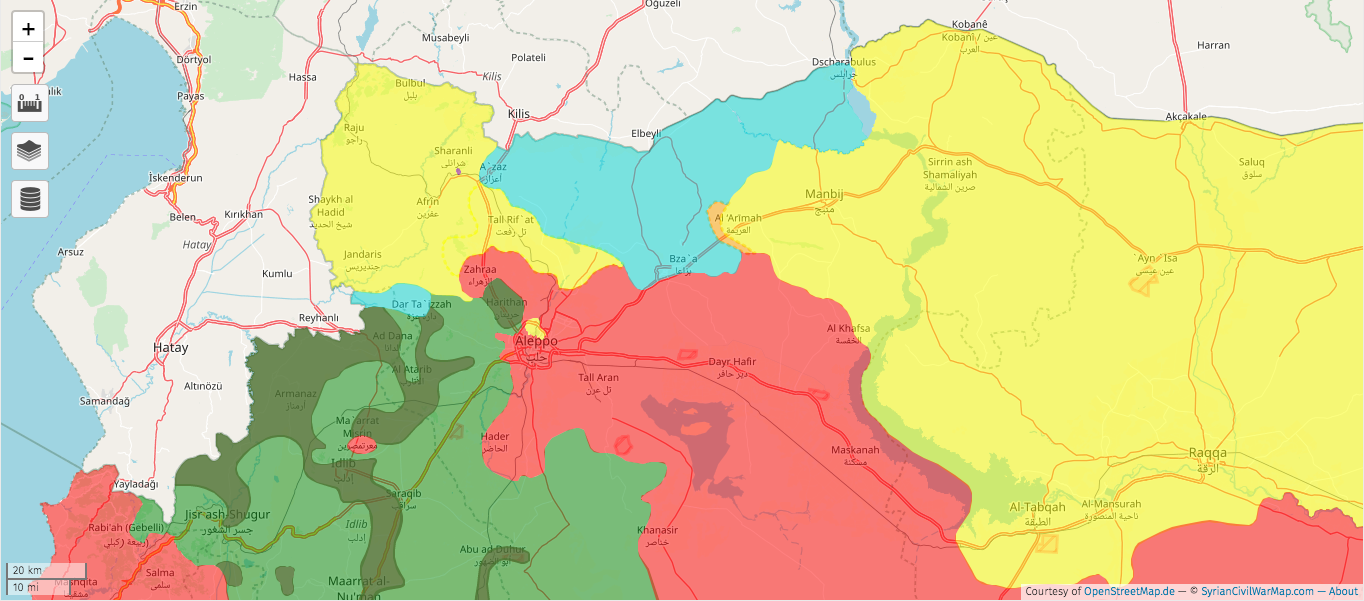
In the two years prior to the SDF Manbij offensive and Euphrates Shield, Turkey generally tolerated ISIL activity along its southern borders with minimal military pushback. This was a consistent policy motivated by the goals of increasing pressure against Bashar al-Assad’s national government based in Damascus, as well as the emerging Kurdish-dominated cantons of northern Syria.
Turkey, at times facilitated, and otherwise passively permitted primarily Sunni militants to filter into armed groups fighting Damascus and controlling parts of Syria, including al-Qaeda linked groups like the Nusra Front (Jabhat-al Nusra) and ISIL. As ISIL solidified control throughout the region, towns like Manbij and al-Bab served as critical ISIL supply nodes.
Ongoing trade relationships and war often coincide in this region, forming complex shadow economies. In 2014, press reports highlighted oil from ISIL-controlled areas exported through villages in Hatay, and also in 2014, weapons in trucks headed for al-Qaeda in Syria and protected by agents from Turkey’s MIT intelligence agency, were intercepted by the Turkish gendarmerie command in the port of Adana, touching off a major scandal. (Turkey’s intricate relationship with its neighbor and trading partner Iran has also been in the news this summer as a former minister was indicted by US authorities for allegedly helping launder hundreds of millions of dollars in order to avoid banking sanctions.)
In 2017, Turkey’s Foreign Ministry released a report (PDF) announcing its strategy to wear down ISIL and finally break up its networks inside Turkey. The report attributes 14 major terror attacks inside Turkey to ISIL; including 10 suicide bombings, which killed 304 people and injured 1,338. The most serious attack was the bombing of a large peace rally at the Ankara train station on Oct. 10 2015 which killed 102 people.
Turkey has tried to label both PYD/YPG and ISIL as terrorist groups threatening its security.
Turkey sees the YPG as an arm of the Kurdistan Workers Party (PKK, KU: Partiya Karkerên Kurdistanê), who ran an extended insurgent campaign against Turkey during the 1980s and 1990s. Originally, PKK pursued what it saw as a Marxist-Leninist strategy of national liberation for Kurds, but its leader Abdullah Öcalan was captured in 1999. While imprisoned, Öcalan led the PKK and its supporters towards the perspectives of ‘democratic confederalism’ expounded by American leftist writer Murray Bookchin. (More about the PKK and Turkish leftist movements linked below)
Both PKK and PYD/YPG see Öcalan as their political leader. The United States and Turkey both assert PKK is a terrorist organization, and Turkey claims that PYD/YPG are the same organization as PKK and attempting to split up Turkey, while PYD/YPG asserts they are not the same as PKK and are aiming for federalization of the region they control in Syria.
PKK and its supporters point to the marginalization of Kurdish communities since the secular Republic of Turkey was founded in 1923 from the collapsed Ottoman Empire. The Kemalist political establishment denied Kurdish identity and language rights, labeling them “mountain Turks”. Kurds revolted in 1925, 1927-31, 1930-38 and the central government finally permitted Kurdish to be spoken in 1991. (More on Turkey’s Kurdish language policy here (PDF).)
At various times since 2000, the Turkish government pursued a peace process with the PKK, although this deteriorated as the Syrian Civil War increased in intensity. During some elections, Erdoğan’s political party, AKP (TR: Adalet ve Kalkınma Partisi), attracted significant Kurdish support because it was more Islamist and potentially more sympathetic to Kurdish interests than the secularist Kemalist party, CHP (TR: Cumhuriyet Halk Partisi), that historically backed the suppression of Kurds.
Across southeastern Turkey, HDP (TR: Halkların Demokratik Partisi), was locally elected at a euphoric moment in 2015. The summer of 2015 was a complex and violent one: ISIL gained a tighter grip in northern Syria, alongside fighting between Kurdish and anti-government rebels, and military activity on both sides of the Turkish border kept increasing as Turkey openly moved militarily against PKK and sought to shore up opponents of Kurdish militias in Syria. On July 25, 2015, the PKK canceled the ceasefire Öcalan had declared in 2013, citing Turkish airstrikes on PKK sites in Iraq.
Political observers noted in late 2015 that many Kurdish voters rejected AKP in Turkish parliamentary elections, as nationalist rhetoric increased during the battle for the Kurdish town of Kobane in Syria.
Pursuing what it saw as an overwhelming military campaign against the PKK and its supporters, the Turkish military dealt harshly with many urban areas of southeastern Turkey, seriously damaging neighborhoods, including the old city of Diyarbakir, a provincial capital on the banks of the Tigris River that is considered a center for Kurdish politics in modern Turkey.
In May 2016, the NGO Mazlumder reported (PDF) in the town of Cizre more than 10,000 homes were destroyed and at least 200 people were killed during military operations and curfews. In September 2016, civil relations reached a new low as Ankara removed elected mayors in 24 primarily Kurdish towns, which had been governed by elected HDP officials.
On April 11th, 2017, the PKK claimed credit for bombing a police station and killing three in Diyarbakir. The Turkish government cited this PKK attack as their pretext for their deadly bombing of Qereçox Mountain at midnight on April 25th (see video below for scenes from the bombing on Qereçox Mountain).

In recent years, the United States has provided direct military assistance, including airstrikes and intelligence to YPG, despite its position that their ideologically related counterparts across the Turkish border are a terrorist organization. Journalists have often documented American special forces in Rojava traveling in Humvees amid YPG/SDF campaigns.
While Afrin and the areas around Manbij and Kobane are predominantly Kurdish, the area between Afrin district, Aleppo, Jarabulus and the Turkish border is populated by groups like Sunni Arabs, Turkmen, Circassians, Shia Imamis, and Arabic-speaking Levantine Christians of different denominations.

Afrin has been declared one of several Rojava cantons (administrative subdivisions) since January 2014. As of October 2017, Reuters reported that Turkish forces have deployed into northwestern Syria in attempts to surround Kurdish Afrin. Turkey is setting up positions at the edges of Afrin district (mantiqah) in Aleppo governorate, 15-20km south and east of the town (Turkey itself lies both north and west of Afrin district.)
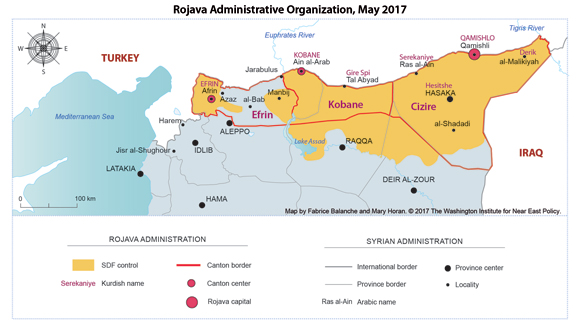
This effectively separates Kurdish-held Afrin from the rebel-held sections of Idlib to its south. However, from the perspective of observers on the Rojava side, Turkey’s goal is to separate Afrin from Aleppo: There is a trade corridor important for economic recovery in Afrin and internally displaced families have taken refuge there; Turkey’s position does not to create a buffer between HTS in Idlib and SDF in Afrin — nor are the Turkish forces positioned to protect much of Idlib from yet another Russian bombing campaign or advances by the Syrian Arab Army.
Reuters also reported some locals in rebel-held areas west of Aleppo city (an area including Turkmen and Levantine Christians), welcome the presence of Turkish military units, since that would deter attacks by the Syrian Arab Air Force (SAAF) and the Russian Air Force (RAF), which have bombed many towns in Aleppo, Idlib, Raqqa and Deir ez-Zor governorates in recent years, with thousands of civilians killed and injured.
According to Reuters, an SDF representative indicated that Turkey’s intelligence units coordinated with Sunni religious militant group HTS (Organization for the Liberation of the Levant, AR: Hayʼat Tahrir al-Sham, هيئة تحرير الشام) to ensure a smooth roll-out into Idlib province.
Although it is not widely reported in the United States, the governments of Turkey, the Islamic Republic of Iran (Jomhuri-ye Eslāmi-ye Irān, Persian: جمهوری اسلامی ایران), the Syrian Arab Republic (SAR, al-Jumhūrīyah al-ʻArabīyah as-Sūrīyah, AR: الجمهورية العربية السورية), and the Russian Federation (Rossiyskaya Federatsiya, RU: Российская Федерация) have moved ahead with the “Astana” process, hosted by Kazakhstan’s government.
This process led to several ceasefires and areas of de-escalation, with the engagement of units from larger external governments, in many parts of Syria by the end of Summer 2017, often under tacit, rather than formally, published understandings with local parties. The Idlib ceasefire zone (also covering parts of Latakia, Aleppo and Hama governorates) was agreed upon on September 14th, 2017.
Although no formally released plan allots a peacekeeper mission to Turkey within Syria west of Aleppo, it’s happening with the acquiescence of Russia, Iran, Syria, and Islamic militant groups operating in Idlib. Turkey is both positioning itself along Afrin and acting directly as a power broker in northern Idlib. (Similarly Russia acts as a power broker in other ceasefire zones under the Astana process – specifically using a new military police (Voennaya politsiya) formation initially created in 2011, including “manning checkpoints and observation stations”.)
Looking farther east, in recent months, the YPG, YPJ units under the leadership of SDF, have expanded their control across Raqqa and Deir ez-Zor governorates in a dramatic advance against ISIL forces that once looked poised to dominate the region.
The following map illustrates the overall balance of power among these groups nationwide and some of the military actions that took place between October 1 and October 15, 2017.
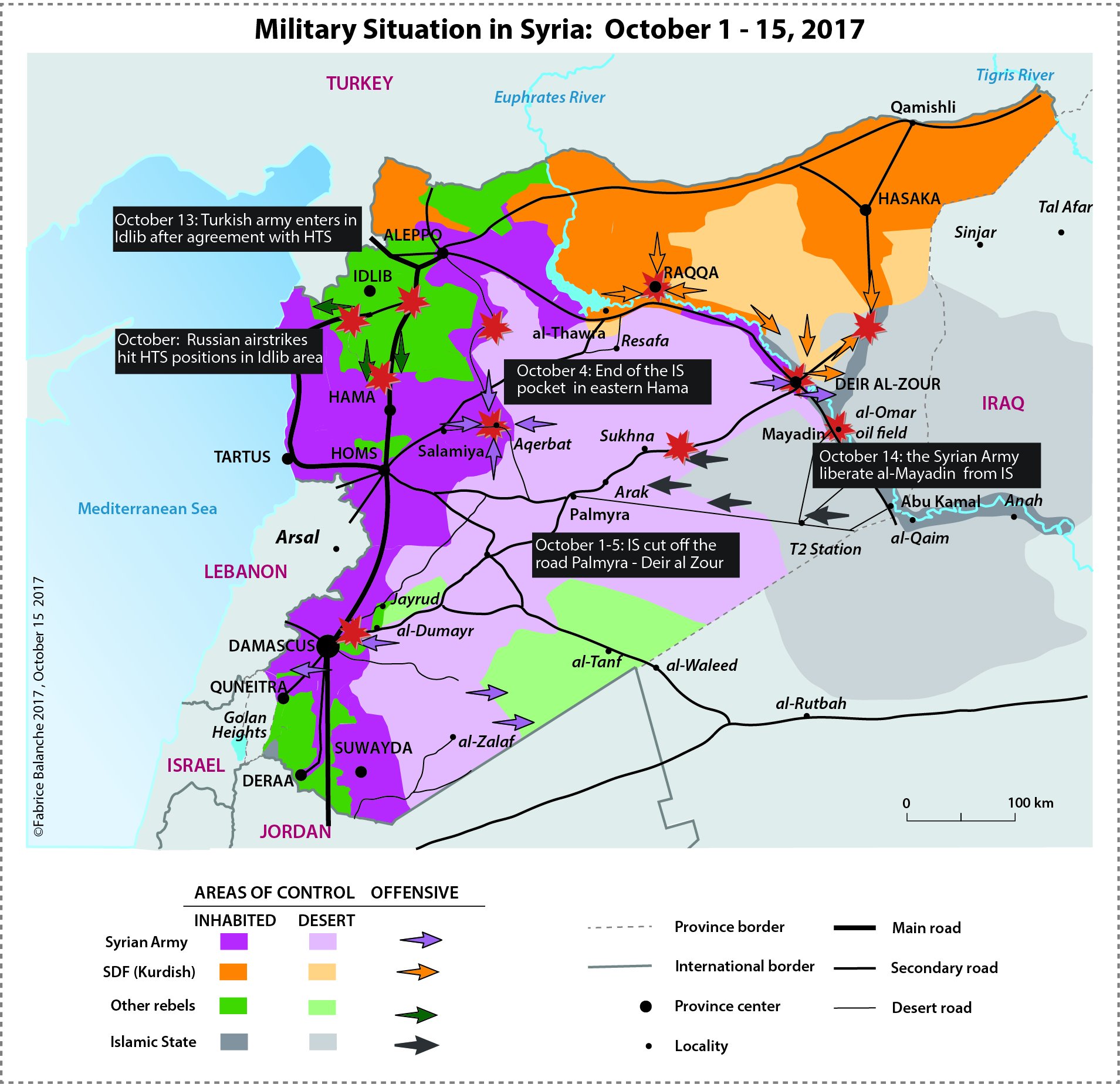
Six months after 24 people were killed in their sleep as the chief of the Turkish army led a bombing operation 20km into northeastern Syria against the Kurdish YPG and YPJ military facility and media headquarters on Qereçox Mountain, a Unicorn Riot contributor brings you this video update from the Democratic Federation of Northern Syria, illustrating the Kurdish perspective on this attack and provides updates from the region. Watch the video from our contributor at the top of the post.
For a new analysis about the history of leftism in Turkey and the role of Kurdish organizers, the fallout from the 1980 military coup, and 2016’s violent coup attempt, see Cengiz Gunes in New Left Review on Turkey’s New Left. In the same issue of New Left Review, another article by Gunes covers how President Erdoğan has repressed the People’s Democratic Party (HDP). HDP is a primarily Kurdish-backed leftist political party that garnered 13% in the 2015 parliamentary elections and is now holding 54/550 seats in Turkey’s Grand National Assembly.
Stay tuned for more contributor reporting on Syria in the coming months.
Unicorn Riot original reporting on Syria:
- International Volunteers of the Rojava Revolution - DOCUMENTARY FILM - (2019)
- Looking Beyond the Rubble: Aiding the Kurds After the Syria, Türkiye Earthquake (April 25, 2023)
- Revolution in Every Country Comic Series: Episode 1 – Syria: Erasing an Inconvenient Revolution (June 5, 2022)
- Origins of the PKK and the ‘Rojava’ Revolution: Part II (September 18, 2021)
- Origins of the PKK and the ‘Rojava’ Revolution: PT. I (August 3, 2021)
- Building Autonomy Through Ecology in Rojava (February 28, 2018)
- Kurdish Fighters Defend Afrin From Turkish Military Invasion in Northern Syria (January 25, 2018)
- Kobane Rebuilds as ISIL Control Diminishes in Syria (December 27, 2017)
- As Course of War Turns, Turkey Challenges Democratic Federation of Northern Syria (Rojava) (October 30, 2017)
- Solecast #20 Rojava Special w/ Janet Biehl (January 9, 2016)
- Pipeline Politics in the Syrian Civil War (September 20, 2015)
- Youth Press Conference Bombed in Turkey - Deprogram Ep. 12 (July 23, 2015)
Please consider a tax-deductible donation to help sustain our horizontally-organized, non-profit media organization:


